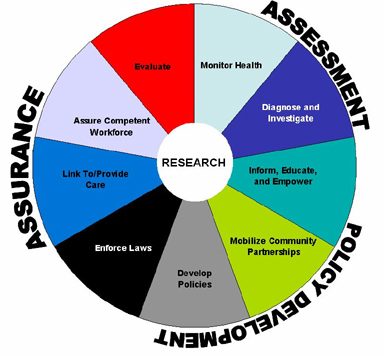Evidence-Based Public Health
Maximizing the health of a population is largely achieved through three core functions of public health; Assessment, policy development, and assurance. Within each core function lies a subset of the 10 essential functions of public health:
As mentioned in the the previous module on ethics, it is essential to consider alternative courses of action to maximize benefit, minimize adverse consequences and make the most efficient use of scarce resources. As a result decisions on how to address public health must be evidence-based, meaning they are based on accurate and complete data which have been rigorously analyzed.
Two broad types of evidence are essential to the practice of public health:
- The Evidence regarding the efficacy and adverse consequences of interventions
- Evidence regarding the determinants of health and disease
In addition, it is useful to have evidence regarding how a disease spreads across a population, including social and political factors. Ex. are there members of the population at higher risk due to behavior, age, preexisting conditions or geography?
Even though most research depends on quantitative data, a fine understanding usually requires qualitative data.
Learning Objectives:
- Describe the general steps involved in identifying and addressing public health problems
- Describe and give examples of the role of surveillance systems in public health
- Explain what is meant by the term "notifiable/reportable disease"
- Describe the breadth of modern public health surveillance systems and give specific examples
- Define "syndromic surveillance" and explain how it can be advantageous over regular surveillance
- Explain how the characteristics of person, place, and time are used to formulate hypotheses in acute disease outbreaks and in studies of chronic diseases
- Distinguish among case reports, case series, cross-sectional surveys, and ecological studies and explain their importance
- Explain the concept of ecologic fallacy
- Describe the difference between descriptive and analytic epidemiologic studies
- Define and explain the distinguish between retrospective and retrospective cohort studies
- Define and explain features of a case-control study
- Explain and distinguish features of of an intervention study (clinical trial)
- List and define 3 major threats to validity in analytical studies
- Describe the contribution of quantitative and qualitative research to public health

